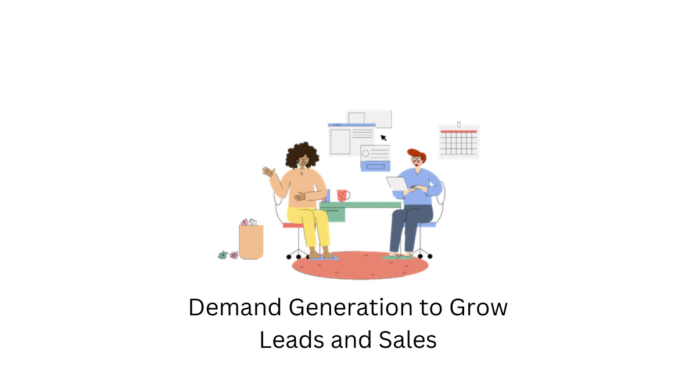You invest a lot of time and money in your marketing efforts. Yet no matter how much you try, the sales are not matching up. Indeed, there is no tangible ROI that compares to what you are spending. A lot of it concerns the quality of leads you’re getting. Many of them turn out to be cold. This means the sales teams are wasting time running around in circles.
The reality is that you are not catching the customer at the right place. Focusing on lead generation will not work out well for you. What you need to concentrate on is demand generation.
Many marketers focus on lead generation in their marketing strategies. Look at the following statistics. Yet, 58% admit that generating leads is the most significant growth challenge.
The lack of appropriate techniques is a major issue. The result is an inability to lure customers into the busy or competitive market. 70% of initial prospects are not looking to buy during the first interaction with your brand. And that would explain why many leads end up in the reject pile.
Yet therein lies a big opportunity for remarketing strategies. 60% of prospects will say no before changing their minds. It can take up to three months before this happens, though. 20% may need up to a year to buy.
So what is demand generation, and why is it the answer to sales and leads?
Understanding Demand Generation


Think of the toy segment for a minute. Have you ever thought about why toys are so colorful and attractive to look at? The thinking behind this is quite simple. It is the best way to generate interest in the kids’ minds. What it does is get the child to want to play with the toy. If you think about it, that is the most basic element behind demand generation.
So we can define demand generation as any process to increase brand awareness. But beyond that, is the goal of creating interest and demand for goods. You make your brand desirable so the customers come to you.
Think about some of the top brands in the market. Nike, Apple, Mercedes, McDonald’s, etc., may spend on advertising. But, they are desirable brands that customers want and seek out.
Why do customers line up for hours for the latest iPhone? Well, the company has positioned itself as a leading brand with trustworthy products. They are leading in innovation, industry authorities, and more. Indeed, the level of customer loyalty some of these brands have is out of this world.
We can summarize lead generation processes as; collecting customer information, nurturing, and converting. But, demand generation is about creating relationships. It follows the rule of pull marketing. That is why it focuses on capturing prospects right at the top of the sales funnel.
Remember, not all customers want to buy during their first brand interaction. The typical behavior of most modern shoppers is to first search for information. At the top of the funnel, they are in the knowledge-seeking phase. They have a need or pain point that needs a solution. So, they set out to find answers.
If you engage with the customer at that stage, you become the solution provider. It will then be easier for the prospect to move further along the funnel.
Demand generation strategies include:-
- Use of social media to engage with prospective clients
- Video content
- Blogs, white papers, eBooks, and other publications
- Live events, webinars
- Reviews and testimonials
- Targeted email marketing, etc.
Better Leads and Sales with Demand Generation
Let’s explore how you can improve leads and sales with demand generation.
Demand Generations for High-Quality Leads


Sales and marketing teams personify sibling squabbles. The former feel the marketing team should only give them qualified leads. The latter will often ignore this core role. They may operate on the principle of “we did the hard work getting leads. So, why not let sales determine their value.” That often leads to friction between the departments.
Well, demand generation can restore the peace between the two. Only prospects who have a genuine interest will move further down the funnel.
Let’s use blogs or explainer videos as demand generation tactics. If the prospect finds value in the content, they will want to know more information. They may even find answers or solutions in the explainer videos.
The interest will signal that the prospect is warming up as a lead. The marketing can then hand over such a lead to sales to nurture and convert.
The prospect will still have other demand generation tactics to keep them engaged. Educational content is great for those in the middle of the funnel. Testimonials, reviews, and case studies can help close the deal.
Improving Sales with Demand Generation Tactics


Brand awareness is critical if you hope to sell. The typical market has so many sellers. Amongst them are your competitors. The truth is some companies may have products or services that are better than yours. So, unless you have something unique, you will have to fight for customers.
Yet, using demand generation tactics can be that differentiating factor. While the competition focuses on brand attributes, you focus on value-added.
As the competitors fight about pricing, showcase solutions and answers to identified problems. As others bombard prospects with advertisements, use more subtle, engaging tactics. Such include blogs, videos, case studies, etc.
We talked about pull marketing above. When you make your brand enticing to customers, they will come. That means moving away from hard-sell marketing techniques. Stop focusing on the product attributes. Instead, show how your offering can change the prospects’ lives.
Content Creation to Improve Sales
What happens when you want to buy a particular good or service? One of the first things you will do is find out more about whatever you want to buy. 81% of retail customers do this before making a purchasing decision. 77% use their mobile devices to browse the internet for product information.


With such knowledge, marketers can use the content as an effective demand generation technique. The advantage is that there is no shortage of content ideas. These include:-
- Blogs are a fantastic way to talk about the brand offering in an informal, engaging manner. There is no limit to the length or style. What you need is clarity on what your target audiences want. You then come up with relevant, interesting topics to capture their attention. Also, ensure relevance and proper research to present factual information.
- Video content works. Wouldn’t you rather watch a video than reading pages of text? Research shows that 84% of markers use videos to generate leads. 93% of companies say social media videos help get new customers. 68% of marketers see better ROI with video than Google Ads. Be strategic about the video content you put up. They could be demos, how-to clips, explainer videos, and more. Like in the case of blogs, there is a lot of flexibility with what you can do.
- Secure the deal with case studies and testimonials. Both are powerful demand generation tactics that work well at the bottom of the funnel. The prospect may need this final push to buy. Such tactics also work very well for B2B demand generation marketing.
- Email marketing is an excellent demand generation tool for targeted marketing. With proper segmentation, you can personalize emails, thus, higher open rates. Further emails can help with remarketing. That way, you don’t dump any leads that don’t give immediate yield.
- Social media provides many channels for reaching customers. The interactive nature of the conversations can increase engagement. Finally, you can use the posts to educate, inform and provide solutions. Indeed, the correct use of social media can be a powerful tool to build trust with the target audiences.
- The website is ideal for posting blogs and video content. But you can also get fantastic insights from the analytics. You can, for instance, know what appeals to your audiences. The feedback can let you know the customer’s pain points and more.
Influencer Marketing For Leads and Sales
Influencer marketing brings in that element of desirability. What happens when you see your favorite celebrity wearing a particular brand? You get the urge to run and buy the same, right?


Influencer marketing is a robust demand generation tool. You can improve your lead generation and sales with the correct implementation. 93% of marketers use influencer marketing. 80% believe it is an effective marketing method. For every dollar you spend on influencer marketing, you achieve $18 in ROI.
But how many brands can afford to hire celebrities? Well, at the high price tag, few can. But the solution lies in micro-influencers. Such individuals have 10,000 to 100,000 followers. What you get is a cohesive follower community.
Indeed micro-influencers are more in touch with their fans than micro-influencers or celebrities. For them, engagement is a critical measure of success. A brand can achieve a lot of traction with micro-influencers even without a huge budget.
Final Thoughts
Demand generation is the answer to more effective sales and marketing efforts. Knowing customers from the top of the funnel can provide excellent insights. You get to understand their pain point and become the solution provider.
Remember, the key to loyal, lifelong customers lies in understanding them. Only then can you tailor-make solutions that meet their needs.
We have looked at ways to use demand generation to improve sales and collect leads. The trick is to create awareness of the company. The next thing to remember is to avoid hard-sell language. Instead, offer solutions and value to prospective customers.











